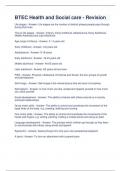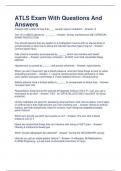Annjeonyango
On this page, you find all documents, package deals, and flashcards offered by seller annjeonyango.
- 293
- 0
- 28
Community
- Followers
- Following
321 items

Health and social care Quiz Test
Health and social care What is health and wellbeing? - Answer- A combination of physical, social, emotional and intellectual wellbeing (not just the absence of disease or illness) What is a holistic approach? - Answer- Meeting the needs of the whole person Where does good physical health come from? - Answer- - Healthy body systems - Regular exercise - A healthy diet - Regular sleep patterns - Access to shelter and warmth - Good personal hygiene Where does good intellectual health...
- Package deal
- Exam (elaborations)
- • 20 pages •
Health and social care What is health and wellbeing? - Answer- A combination of physical, social, emotional and intellectual wellbeing (not just the absence of disease or illness) What is a holistic approach? - Answer- Meeting the needs of the whole person Where does good physical health come from? - Answer- - Healthy body systems - Regular exercise - A healthy diet - Regular sleep patterns - Access to shelter and warmth - Good personal hygiene Where does good intellectual health...

BTEC Health and Social care - Revision
BTEC Health and Social care - Revision Life stages - Answer- Life stages are the number of distinct phases people pass through during their lives. The six life stages - Answer- Infancy, Early childhood, Adolescence, Early Adulthood, Middle Adulthood and Late Adulthood Age range of Infancy - Answer- 0 - 2 years old Early childhood - Answer- 3-8 years old Adolescence - Answer- 9-18 years Early adulthood - Answer- 19-45 years old Middle adulthood - Answer- 46-65 years old Late...
- Package deal
- Exam (elaborations)
- • 7 pages •
BTEC Health and Social care - Revision Life stages - Answer- Life stages are the number of distinct phases people pass through during their lives. The six life stages - Answer- Infancy, Early childhood, Adolescence, Early Adulthood, Middle Adulthood and Late Adulthood Age range of Infancy - Answer- 0 - 2 years old Early childhood - Answer- 3-8 years old Adolescence - Answer- 9-18 years Early adulthood - Answer- 19-45 years old Middle adulthood - Answer- 46-65 years old Late...

Health and Social Care - Unit 2
Health and Social Care - Unit 2 Dietary Requirements - Answer- Vegetarians - no fish or meant Vegans - no meat or animal related products Muslims/Jews - no pork - Muslims - halal Jews - kasher Hindus/Sikhs - no beef Coeliac disease - no gluten Assessing care and providing support - Answer- Assess the clients needs - plan and agree care - implement the plan - monitor effectiveness - review and evaluate - amend the plan if necessary Health and social care workers have to.. - Answer- P...
- Package deal
- Exam (elaborations)
- • 10 pages •
Health and Social Care - Unit 2 Dietary Requirements - Answer- Vegetarians - no fish or meant Vegans - no meat or animal related products Muslims/Jews - no pork - Muslims - halal Jews - kasher Hindus/Sikhs - no beef Coeliac disease - no gluten Assessing care and providing support - Answer- Assess the clients needs - plan and agree care - implement the plan - monitor effectiveness - review and evaluate - amend the plan if necessary Health and social care workers have to.. - Answer- P...

Health and Social Care
Health and Social Care Definition of a stroke - Answer- When the blood supply is cut off/interrupted to the brain Stroke diagnostics [3] - Answer- MRI scan CT scan Swallowing screening Stroke advice [5] - Answer- Having a healthy diet To reduce cholesterol levels Exercise Stopping smoking Cutting down on alcohol Stroke symptoms [8] - Answer- Drooped face/eyes Unable to lift arms Slurred speech Sudden headache with neck stiffness Loss of/blurred vision Unable to talk Paralys...
- Package deal
- Exam (elaborations)
- • 25 pages •
Health and Social Care Definition of a stroke - Answer- When the blood supply is cut off/interrupted to the brain Stroke diagnostics [3] - Answer- MRI scan CT scan Swallowing screening Stroke advice [5] - Answer- Having a healthy diet To reduce cholesterol levels Exercise Stopping smoking Cutting down on alcohol Stroke symptoms [8] - Answer- Drooped face/eyes Unable to lift arms Slurred speech Sudden headache with neck stiffness Loss of/blurred vision Unable to talk Paralys...

ATLS Exam With Questions And Answers
ATLS Exam With Questions And Answers Patients with a GSC of less than ___ usually require intubation. - Answer- 8 The "A" in ABCD stands for _______. - Answer- Airway maintenance with CERVICAL SPINE PROTECTION You should assume that any patient in a multisystem trauma with an altered level of consciousness or blunt injury above the clavicle has what type of injury? - Answer- Cervical spine injury Flail chest is invariably accompanied by ______ which can interfere with blood oxygenati...
- Package deal
- Exam (elaborations)
- • 32 pages •
ATLS Exam With Questions And Answers Patients with a GSC of less than ___ usually require intubation. - Answer- 8 The "A" in ABCD stands for _______. - Answer- Airway maintenance with CERVICAL SPINE PROTECTION You should assume that any patient in a multisystem trauma with an altered level of consciousness or blunt injury above the clavicle has what type of injury? - Answer- Cervical spine injury Flail chest is invariably accompanied by ______ which can interfere with blood oxygenati...

ATLS practice questions
ATLS practice questions Assessed first in trauma patient - Answer- Airway (*)Degree of burn that is characterized by bone involvement - Answer- Fourth Complications of head trauma - Answer- Intracerebral hematoma Extradural hematoma Brain abscess Most common cause of laryngotracheal stenosis - Answer- Trauma Intervention that can help prevent development of acute renal failure - Answer- Infusion of normal saline A 26-year-old male is resuscitated with blood transfusion after a ...
- Package deal
- Exam (elaborations)
- • 30 pages •
ATLS practice questions Assessed first in trauma patient - Answer- Airway (*)Degree of burn that is characterized by bone involvement - Answer- Fourth Complications of head trauma - Answer- Intracerebral hematoma Extradural hematoma Brain abscess Most common cause of laryngotracheal stenosis - Answer- Trauma Intervention that can help prevent development of acute renal failure - Answer- Infusion of normal saline A 26-year-old male is resuscitated with blood transfusion after a ...

ATLS QUIZ TEST
ATLS QUIZ TEST What characterizes a full-thickness burn? How will the surface look? dry or wet? redness? degree of swelling? - Answer- Appear dark and leathery, or skin can appear translucent or waxy white. Surface is usually PAINLESS and generally dry though may be red but does NOT blanch white with pressure. There is little swelling, though surrounding tissue may have dignificant amount. What is the distribution of TBSA for the adult body per the rule of 9s? - Answer- Head = 4.5% front ...
- Package deal
- Exam (elaborations)
- • 15 pages •
ATLS QUIZ TEST What characterizes a full-thickness burn? How will the surface look? dry or wet? redness? degree of swelling? - Answer- Appear dark and leathery, or skin can appear translucent or waxy white. Surface is usually PAINLESS and generally dry though may be red but does NOT blanch white with pressure. There is little swelling, though surrounding tissue may have dignificant amount. What is the distribution of TBSA for the adult body per the rule of 9s? - Answer- Head = 4.5% front ...

ATLS Practice Examination
ATLS Practice Definitive control of the airway is achieved by ____________ - Answer- Endotracheal intubation How do you treat hypothermia in the ED? - Answer- crystalloid fluids at 102.2 degrees F and warmed treatment area What does definitive hemorrhage control refer to? (3) - Answer- 1) Possible surgery 2) Stabilizing of pelvis 3) Angioembolization What are rates of fluid administration measured by? - Answer- Size and length of catheter Minimum flow rate of oxygen reservoir mas...
- Package deal
- Exam (elaborations)
- • 8 pages •
ATLS Practice Definitive control of the airway is achieved by ____________ - Answer- Endotracheal intubation How do you treat hypothermia in the ED? - Answer- crystalloid fluids at 102.2 degrees F and warmed treatment area What does definitive hemorrhage control refer to? (3) - Answer- 1) Possible surgery 2) Stabilizing of pelvis 3) Angioembolization What are rates of fluid administration measured by? - Answer- Size and length of catheter Minimum flow rate of oxygen reservoir mas...

ATLS Examination
ATLS Missed/associated injury with a displaced thoracic spine fracture? - Answer- thoracic aortic rupture Missed/associated injury of a posterior knee dislocation? - Answer- femoral fracture and posterior hip dislocation Missed/associated injury of a knee dislocation or displaced tibial plateau fracture? - Answer- Popliteal artery and nerve injuries Missed/associated injury of a calcaneal fracture? - Answer- Spine injury or fracture, tibial plateau fracture When are most extremity...
- Package deal
- Exam (elaborations)
- • 15 pages •
ATLS Missed/associated injury with a displaced thoracic spine fracture? - Answer- thoracic aortic rupture Missed/associated injury of a posterior knee dislocation? - Answer- femoral fracture and posterior hip dislocation Missed/associated injury of a knee dislocation or displaced tibial plateau fracture? - Answer- Popliteal artery and nerve injuries Missed/associated injury of a calcaneal fracture? - Answer- Spine injury or fracture, tibial plateau fracture When are most extremity...

bsc1005 energy
bsc1005 energy Based on the First Law of Thermodynamics, select all of the following that apply to energy. - Answer- Energy can be transferred. Energy can be transformed. the __________________ Law of Thermodynamics states that energy cannot be created or destroyed, but can only be transferred or transformed. - Answer- first Which of the following characteristics are shared by all living things? Select all that apply. - Answer- The ability to acquire energy The ability to use energy...
- Exam (elaborations)
- • 7 pages •
bsc1005 energy Based on the First Law of Thermodynamics, select all of the following that apply to energy. - Answer- Energy can be transferred. Energy can be transformed. the __________________ Law of Thermodynamics states that energy cannot be created or destroyed, but can only be transferred or transformed. - Answer- first Which of the following characteristics are shared by all living things? Select all that apply. - Answer- The ability to acquire energy The ability to use energy...
